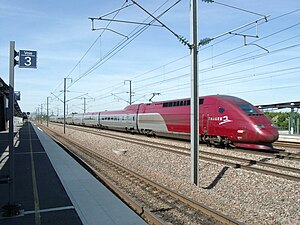Gare TGV Haute-Picardie
| SNCF | |

A Thalys train passing through the station
|
|
| Location |
Ablaincourt-Pressoir Somme, Picardy |
| Coordinates | 49°51′33″N 2°49′54″E / 49.85917°N 2.83167°ECoordinates: 49°51′33″N 2°49′54″E / 49.85917°N 2.83167°E |
| Owned by | SNCF |
| Operated by | SNCF |
| Line(s) | LGV Nord |
| Platforms | 2 |
| Tracks | 4 |
| Train operators | TGV |
| History | |
| Opened | 3 July 1994 |
| Location | |
TGV Haute-Picardie is a railway station on the LGV Nord-Europe between Lille and Paris. Geographically, it is located about 10 km (6.2 mi) west of Péronne, between the towns of Saint Quentin and Amiens, in the heart of the Battle of the Somme territory. When built, it was criticised by the press for being too far from any of the neighbouring towns to be useful. It was located near a trunk road rather than a connecting railway line: it was often nicknamed la gare des betteraves, or 'sugar beet station', as it is surrounded by sugar beet fields, as it was the case for some rail stations in the countryside at the beginning of the twentieth century, when those vegetables were still transported by train towards the next sugar refinery.
Today, the station is connected with the two local main cities, namely Amiens to the west and Saint Quentin to the east, by the A29 motorway – it takes around 30 minutes to reach either city and a bus shuttle service operates.
The annual number of passengers varies from 360,000 to 400,000.
As a very small TGV station, from the point of view of watching the trains the platform is only a few metres from the main running lines, where trains pass by at 300 km/h (190 mph), and there is a good view of the lines in both directions. At most stations on high-speed lines there is some form of barrier preventing this close up viewing from the platform. Since 2013, passengers are not allowed onto the platforms until the arrival of the next stopping train, in order to avoid any risk of being hit by flying track ballast.
A business park has been created around the station for some years, on its western side, and companies have now installed offices or production units. Other implantations are waited.
...
Wikipedia

